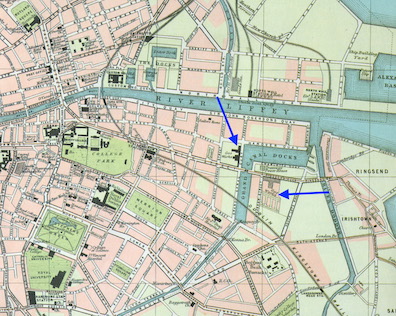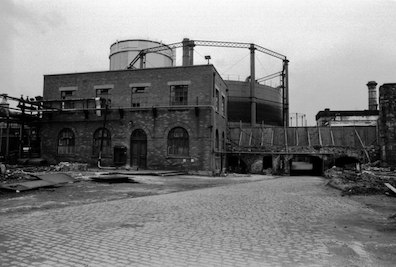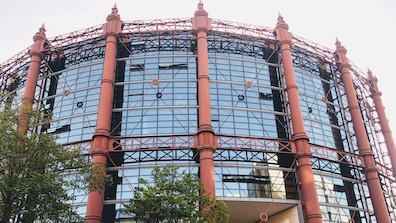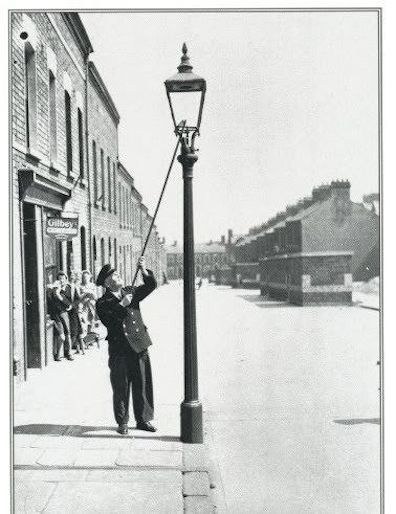In Hades Bloom notes that the carriage is nearing a
"Gasworks" plant, and many later chapters glance at its
product. Cities in Britain, America, and Europe had been
building these coal gasification facilities for nearly a
hundred years, and they remained important well into the 20th
century, until electricity and "natural" gas from drilled
wells put them out of business. More than 3,000 Dublin
streetlights were fueled by coal gas, and most middle-class
homes had at least one room lit by it.
Gasworks plants,
which heated coal in sealed chambers to very high temperatures,
were one of the major industrial advances of the 19th century.
Lacking oxygen to combine with, the coal gave off a mix of gases
like methane, hydrogen, and ethylene that could be burned far
more efficiently and cleanly than coal itself. The product was
stored in huge structures called gasholders or
gasometers––cylindrical iron frames inside which piston-like
caps rose and fell as gas was pumped in or out. The frame of one
of these structures still stands in eastern Dublin, repurposed
as an apartment building. From such storage facilities gas was
piped throughout cities to produce light and heat. The light
from coal gas lamps was both bright and soft. When electric
light finally conquered the world, many people found it
intolerably harsh by comparison.
The accompanying map shows two gasworks facilities in eastern
Dublin in 1900, one just south of the Ringsend Road and the
other just north of that road's continuation as Great Brunswick
Street. Since Bloom notes that the carriage is passing over "
The
Grand Canal" just before he thinks of the "
Gasworks,"
it seems likely that he has the latter in mind, but the carriage
passes by both facilities in quick succession and both were
owned by the same company.
Thom's 1904 directory lists
an Alliance and Consumer Gas Company at 110 Great Brunswick
Street. This company, known officially as the Alliance &
Dublin Consumers' Gas Company and informally as the Dublin Gas
Company, also built the Alliance Gasometer that is now an
apartment building on South Lotts Street, within the boundaries
of what was once the more southerly facility.
Most of the nighttime chapters in
Ulysses mention coal
gas lighting. In
Nausicaa Gerty reflects that soon "
the
lamplighter would be going his rounds," reaching up with a
long pole to ignite the gas in the streetlights. In homes,
valves on fixtures allowed the lights to be turned up or dimmed.
In
Circe, after Zoe declares "More limelight, Charley,"
she "
goes to the chandelier and turns the gas full cock."
Kitty then "
Peers at the gasjet" and asks, "
What ails
it tonight?" It seems the pressure in the pipes has
declined––a common complaint highlighted in the two movies
titled
Gaslight (1940, 1944). When Bloom gains entry to
his kitchen in
Ithaca he lights a fixture with a match
and then adjusts its flame downward: he "
set free inflammable
coal gas by turning on the ventcock, lit a high flame which,
by regulating, he reduced to quiescent candescence." In
addition to the ventcocks on individual fixtures, it appears
that each house also had a main valve that could be turned off
at night for safety's sake.
Nausicaa observes that "
It
was Gerty who turned off the gas at the main every night,"
and in
Penelope Molly worries about Poldy "
leaving
the gas on all night."
The strangest mention of gas lighting in the novel comes at
the beginning of Ithaca, which lists among many
intellectual topics discussed by Stephen and Bloom "the
influence of gaslight or the light of arc
and glowlamps on the growth of adjoining paraheliotropic
trees." Paraheliotropism is the phenomenon of plants angling
their leaves toward sources of incoming light, so the two men
are discussing whether the new electric light bulbs may have a
lesser or greater effect on the growth of any urban trees
growing near them. The inconsequentiality of this discussion,
presumably initiated by the scientific-minded Bloom as he and
Stephen walk along city sidewalks under trees and
streetlights, is emphasized a moment later, after an account
of various weighty issues on which the two men have found
themselves in agreement or disagreement:
Was there one point
on which their views were equal and negative?
The influence of gaslight or
electric light on the growth of adjoining paraheliotropic
trees.

Detail of 1900 Bartholomew's map with added arrows showing
locations of gasworks along Ringsend Road and Great Brunswick
Street.
Source: Pierce, James Joyce's Ireland.

1985 photograph of two cylindrical gasometers on a site next
to Sir John Rogerson's Quay, built later than the facility
mentioned in Ulysses.
Source: Wikimedia Commons.

The Alliance Building on South Lotts Street, originally an
1885 gasometer.
Source: www.theoblochet.com.

Photograph of a Dublin Corporation lamplighter, date unknown.
Source: reynoldshistorycastleknockblog.wordpress.com.



